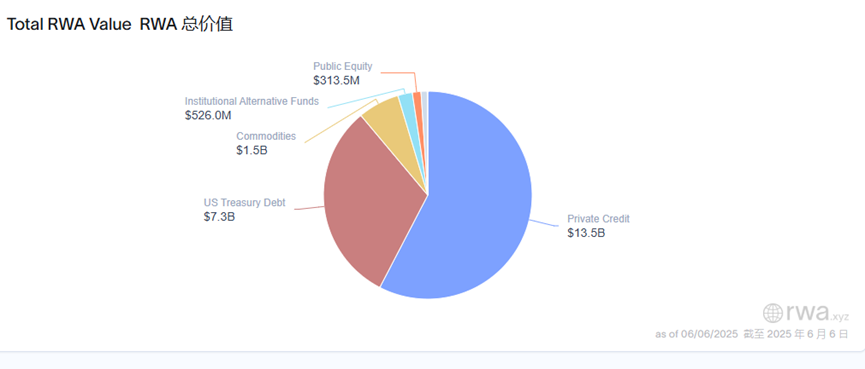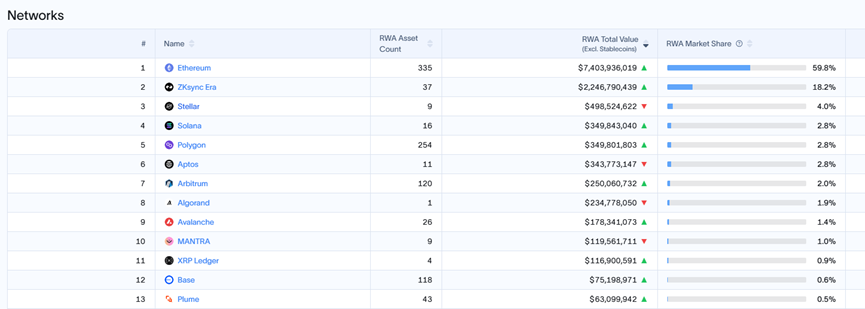Digital analysis of the RWA market: The market size surged 48% in the first half of the year, and ZKsync rebounded to be
المؤلف الأصلي: فرانك، PANews
In the first half of 2025, a relatively low-key track in the تشفيرcurrency world – the tokenization of real-world assets (RWA) – has seen a remarkable explosive growth. As of June 6, the total market value of the global RWA market has soared to US$23.39 billion (excluding stablecoins), a sharp jump of 48.9% from US$15.7 billion at the beginning of the year. Behind this growth, private credit (accounting for about 58%) and US Treasury bonds (accounting for about 31.2%) constitute the absolute dual core of the market, and the two together account for nearly 90% of the market share.
However, behind this impressive report card lies deep-seated problems such as highly concentrated asset categories, limited liquidity, questionable transparency, and low correlation with the crypto-native ecosystem. RWA still has a long way to go before it can become a truly “mainstream track”.

Private credit + US Treasury bonds account for 90% of the market
Private credit has become the most popular asset type in the RWA market, with a total size of US$13.5 billion, accounting for approximately 57.7%
Figure topped the list with $10.19 billion in active loans. Figure is a blockchain financial technology service platform. Its main business is home equity lines of credit (HELOC), which allows users to obtain a credit line loan of up to 85% of the value of their home. According to its official data, HELOC has become the number one non-bank home equity line of credit in the United States, providing a total of more than $15 billion in credit line loans.

However, unlike other RWAs that are generally issued on broad public chains, the Provenance blockchain used by Figure is a public but permissioned L1 blockchain. This design similar to a consortium chain allows Figures RWA assets to be better managed on the one hand, but also blocks the possibility of such assets being widely circulated in the market on the other hand. Therefore, although Figures RWA issued assets have reached more than 10 billion US dollars, they are actually not highly correlated with the crypto market. These assets are mainly on the chain in the form of mortgage notes. As of now, this part of the market share does not have the attributes of transaction circulation. According to the conventional تحديnition of RWA assets, Figures RWA assets are an atypical RWA.
U.S. Treasuries are the second-highest asset class in terms of market share for RWAs. The operating logic of this type of RWA is to convert traditional U.S. Treasury bonds, cash, repurchase agreements and other dollar-denominated assets into digital tokens through blockchain technology. In the field of U.S. Treasuries, the largest issuance is BUIDL issued by BlackRock, with a current total issuance of approximately $2.9 billion.

The BUIDL fund was initially launched on the Ethereum blockchain and has now expanded to multiple blockchain networks including Solana, Aptos, Arbitrum, Avalanche, Optimism, and Polygon. The vast majority of the BUIDL fund’s assets (approximately 93%) are still issued on Ethereum.
This RWA has better flexibility than the traditional way of directly purchasing US Treasury bonds, providing 24/7 liquidity. Traditional Treasury bond transactions may take several days to complete. However, BUIDL is currently open to qualified investors, with a minimum investment threshold of US$5 million and the current number of holders is 75. In addition, BUIDL has also launched a DeFi-compatible version sBUIDL, which is an ERC-20 token representing a 1:1 claim on the BUIDL fund. sBUIDL can interact with DeFi protocols such as Euler.
Commodities are the third largest RWA asset class after private credit and U.S. Treasuries, and this category is dominated by tokenized gold issued by institutions such as Paxos and Tether, with a current total market value of approximately $1.51 billion.
ZKsync and Stellar become the dark horses of public chains in the RWA market
In the comparison of public chains, Ethereum is still the most favored blockchain network for RWA assets. The current market value of 7.4 billion US dollars accounts for 55% (it should be noted here that this proportion is relative to all assets issued on the public chain, which is about 12.55 billion US dollars. Assets issued by Figure on its own public chain are not included in the statistics).

Among them, the $2.7 billion in assets issued by BUIDL constitute 36.48% of Ethereum, and the rest are tokenized gold such as PAXG and XAUT.
In the comparison of public chains, it is more surprising that ZKsync has become the second highest RWA public chain with an asset issuance of US$2.25 billion. The reason why ZKsync can obtain so much RWA asset issuance is mainly due to Tradable, an asset management company that introduces web3 technology. Tradable allows institutions to initiate investment opportunities on its applications and explain the specific investment purposes and transaction information. Investors choose to invest in what they are interested in based on these investment opportunities, such as fintech senior secured loans, which raised US$110 million and a return rate of 15%. Or a term loan provided to a first-class law firm, with a return rate of 15.5% and a financing amount of US$57 million. According to official data from Tradable, there are currently 34 assets online, with an average APY of 10%. However, the company obviously lacks motivation in external publicity and operations. It has only retweeted 2 news on Twitter and has not actively released any original content. The official news page also stays in the news of 2023. 
In addition, after checking the contract information of Tradable, PANews found that these contracts were not open source contracts, and there was no interaction with encrypted assets. All contracts showed that the tokens were zero. Therefore, from this perspective, there are certain doubts about the actual amount of Tradables RWA assets on the chain.

In addition, Stellar is the third-ranked network in the RWA market, which is also an unexpected result. The current RWA asset issuance of the network is about 498 million US dollars, of which BENJI issued by Franklin Templeton is about 489 million and has become the absolute main force. BENJI is also a monetization fund based on US Treasury bonds, with a total issuance of about 770 million US dollars, of which 63% is issued on the Stellar chain.
Stellar, as an old public chain founded in 2014, has gradually faded out of the mainstream public chain market in recent years. In 2024, the Soroban smart contract platform was launched, and a $100 million adoption fund was launched to promote the development and construction of projects. In addition, it has also promoted cooperation with multiple contract institutions such as Franklin Templeton, Paxos, and Circle in the past year, which has also made Stellar surpass popular public chains such as Solana in the RWA field and become the third-ranked RWA issuance public chain. However, from a structural point of view, Stellars RWA asset issuance transition relies on Franklins issuance volume, which is relatively simple.
The RWA issuance of the Solana network ranks fourth, at about $349 million. Although the order of magnitude is not large, the growth rate has increased by 101% since January 2025, which is a relatively fast growth rate. In terms of distribution categories, it is also dominated by U.S. Treasury bonds.
Behind the impressive data, the RWA market faces hidden challenges
Judging from the data, the growth of the RWA market is impressive, but it seems that there are some potential challenges behind this impressive growth.
First, the asset categories are mainly concentrated in private credit and US Treasury bonds. The data of Figure and Tradable, the leading projects in private credit, are not transparent. And Figures RWA assets essentially only exist in the form of on-chain, and most of them do not have trading attributes. From this perspective, this type of asset has not really played the role of blockchain technology in improving the liquidity and transparency of traditional assets.
Second, in the field of treasury bonds, many products are similar to the issuance methods of stablecoins. In fact, interest-bearing stablecoins backed by U.S. Treasury bonds also provide similar benefits in essence. RWA products centered on treasury bonds face competitive pressure from stablecoins.
Third, asset categories are too concentrated. Although RWA has been around for several years, the main players are still concentrated in the issuance of government bonds and private credit assets (accounting for nearly 90%). Commodity, stock, and fund products still account for a very low proportion. The development of this type of asset is limited mainly because of challenges such as physical storage, legal compliance, and cost.
As of now, the total size of the RWA market is only 23.3 billion US dollars, which is far from the size of the stablecoin market (236 billion US dollars), and even less than the market value of some newly issued public chain tokens. This scale is far from the markets imagination of the so-called trillion-dollar scale of RWA. From the perspective of asset operation, the current RWA is almost a special field for institutions and big players, and is far away from the traditional operation mode of the crypto market. For ordinary investors, it seems to be difficult to participate in the RWA track, and RWA still has a long way to go before it becomes a new outlet for retail investors.
Overall, the RWA market in the first half of 2025 did deliver a nearly 50% surge in market value, and the dual-headed pattern of private credit and US Treasury bonds has become increasingly clear. The potential of RWA is unquestionable, but how to break through the current bottleneck and achieve qualitative changes in transparency, liquidity and ecological integration will be the key to determining whether it is a flash in the pan or a new chapter in finance.
This article is sourced from the internet: Digital analysis of the RWA market: The market size surged 48% in the first half of the year, and ZKsync rebounded to become the second largest public chain
This article is jointly released by Aquarius Capital and Klein Labs . Special thanks to ecological projects such as NAVI Protocol , Bucket Protocol and Comma 3 Ventures for their technical guidance and support during the research process. TL;DR 1. The Cetus vulnerability originates from the contract implementation, not SUI or Move language itself The root cause of this attack is the lack of boundary checking of arithmetic functions in the Cetus protocol – a logical vulnerability caused by mask over-width and displacement overflow, which has nothing to do with the resource security model of the SUI chain or Move language. The vulnerability can be fixed with one-line boundary checking without affecting the core security of the entire ecosystem. 2. The “reasonable centralization” in the SUI mechanism shows its value…







